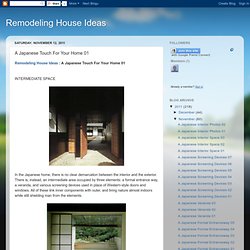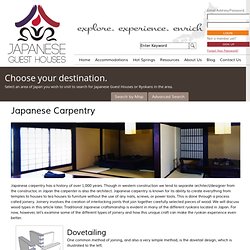

JAANUS / fusuma 襖. Japan: Architecture. Like the Chinese, Japanese architecture is governed by axiality and hierarchy.

Public and private buildings appear as works of art in beautiful environments. To impress, public complexes express monumental scale, but may be a combination of many separate buildings that individually offer personal intimacy. Construction, detailing, decoration, and color reflect the various religions and the importance of nature. Because of the possibilities of earthquakes and fire, houses are constructed so they are easy to rebuild. Public buildings include temples, shrines, pagodas, and shops. Temple- Domestic building types include noble residences, palaces or castles, town houses, besso (country houses), and farmhouses. Shinden style- Features a main dwelling in the center with covered walkways extending to one story rectangular pavilions to the east and west.
Tea Houses- are characterized by simplicity, naturalism, careful planning, and integration into the landscape. Japanese farmhouse- Like this: Simple Ways to Create Japanese Architecture Homes: Japanese Architecture Homes, Glass Window Design – awants. « Go to Article : Simple Ways to Create Japanese Architecture Homes Simple Ways to Create Japanese Architecture Homes : Japanese Architecture Homes, Glass Window Design This Japanese Architecture Homes, Glass Window Design picture is one of the image among other images in the article of Simple Ways to Create Japanese Architecture Homes The cool Japanese Architecture Homes, Glass Window Design picture above, is categorized in Interior Design subject with Living Room topic and also Floor subject as well as Decorating subject in conjunction with Accessories category as well as Interior Styles subject with Dream Houses subject and also Exterior category as well as Outdoor subject.
A Japanese Touch For Your Home 01. Remodeling House Ideas : A Japanese Touch For Your Home 01 INTERMEDIATE SPACE In the Japanese home, there is no clear demarcation between the interior and the exterior.

There is, instead, an intermediate area occupied by three elements: a formal entrance way, a veranda, and various screening devices used in place of Western-style doors and windows. All of these link inner components with outer, and bring nature almost indoors while still shielding man from the elements. A simple wooden veranda serves as an important intermediary between this study and the garden. Bamboo blinds modulate the amount of light and ventilation, and also provide privacy. An inner courtyard shared by all of the rooms in this house gives continuity to the living space, in addition to providing an area for solitary relaxation or an outdoor party.
Tokyo, Japan: Traditional and Historical Architecture. Traditional Japanese Architecture, Design & Woodworking. Photo Gallery. East Wind, Inc. Japanese Carpentry (without nails) - Japanese Guest Houses: Japanese carpentry has a history of over 1,000 years.

Though in western construction we tend to separate architect/designer from the constructor, in Japan the carpenter is also the architect. Japanese carpentry is known for its ability to create everything from temples to houses to tea houses to furniture without the use of any nails, screws, or power tools. This is done through a process called joinery. Joinery involves the creation of interlocking joints that join together carefully selected pieces of wood. We will discuss wood types in this article later.
Dovetailing One common method of joining, and also a very simple method, is the dovetail design, which is illustrated to the left. Various Joinery Techniques Though dovetailing is effective at joining boards together, it is a relatively novice technique that is more appropriate for small-scale projects than larger ones. Joinery as seen in a Large-Scale Project There are generally four types of master Japanese carpenters/woodworkers.